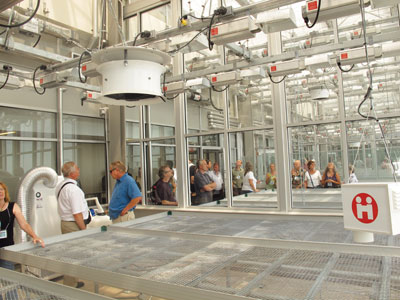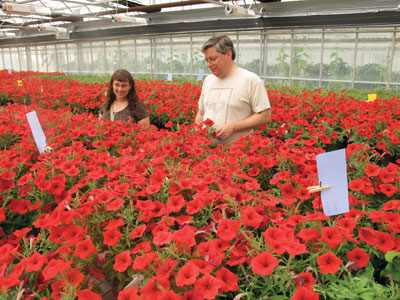
Want to get more out of your chemical controls? Start by taking more time to review the label.
Want to get more out of your chemical controls? Start by taking more time to review the label.
 |
|
| AERGC delegates toured Brock’s new greenhouses Advertisement
|
Dr. Raymond Cloyd, of Kansas State University, said pesticide labels contain a wealth of information. It’s especially important when tank mixing.
“Always read the label of all pesticides to be mixed together,” Cloyd told delegates attending the conference of the Association of Education and Research Greenhouse Curators, held at the University of Toronto.
That label review will let you know what chemicals can – and can’t – be mixed together.
Test things out on a small sample of plants, added Cloyd, and keep a record of those mixtures that are – and are not – harmful to plants.
There are many benefits to tank mixing, including labour savings, a reduced number of applications, and improved pest control.
The best result is “synergism,” when two pesticides, mixed together, perform better (based on per cent mortality of target pests) than when applied separately.
Mixing incompatible controls, however, can lead to “antagonism,” where the overall effectiveness of one or all of the pesticides is reduced.
Some 120 delegates registered for the conference this year, including about 40 from Canadian facilities or companies.
APPLIED RESEARCH EMPHASIS AT NIAGARA COLLEGE
■ Olga Piedrahita, an instructor with Niagara College, outlined the school’s Greenhouse Technician program, including its research component.
 |
|
| Joan and Pat Leonard from Ohio State University look over VRIC benches.
|
“We’re well known for our applied research,” she said. Students have worked with many leading industry suppliers in trialling new products and processes.
An advisory committee plays a key role in ensuring the program meets the needs of the industry and remains relevant. It also fosters close links with area greenhouses and suppliers.
The school benefits from being located within one of the largest greenhouse regions in North America.
COMMERCIAL-SCALE ROOFTOP GREENHOUSE
■ Among other speakers at the conference was Kurt Lynn, vice-president and co-founder of Lufa Farms, the world’s first commercial-scale rooftop greenhouse.
The 31,000-square-foot greenhouse sits atop a commercial building in Montreal. It grows a complete basket of vegetables, supplemented by locally grown organic vegetables.
The concept was launched about four years ago, with construction finally getting underway in September 2010. The first vegetables were harvested in April 2011.
Milestones after one year include:
- Production of more than 250,000 pounds of vegetables.
- About 1,000 year-round subscribers. (Weekly basket prices begin at $22.)
- Fifty distribution drop points throughout Montreal.
Two more projects are being planned – one of 44,000 square feet, and the other of 120,000 square feet.
In addition to providing new revenue sources arising from building roofs, the concept also offers a clear “green/sustainability” option for
cities. “New levels of sustainability can be achieved on a larger scale,” said Lynn.
NIAGARA FOCUS OF BUS TOUR
■ Delegates enjoyed a day of touring in the Niagara region, including stops at Priva Computers, the Vineland Research and Innovation Centre (VRIC), Brock University and Niagara College.
Brock’s new $2-million rooftop greenhouse complex – one of the most advanced in North America – features advanced temperature and humidity control systems.
The Brock program will handle a variety of research themes, including work with medicinal plants.
Helping host the visit was Prof. Vincenzo De Luca, a Canada Research Chair in plant biotechnology.
Among Niagara College projects highlighted was a screening project of native plants for green roofs. Among ideal characteristics for such plants are:
- Drought tolerance.
- Ability to tolerate full sun exposure.
- Ability to withstand high winds.
- Limited tap root system (maximum depth of four inches).
- Soil and pH adaptability.
- Low maintenance.
- Overall appearance.
During the visit to Priva North America, delegates were able to tour the control panel assembly department, among other stops.
INDUSTRY SERVICE AWARDS
■ A pair of awards were presented during the conference.
Clinton Morse, of the University of Connecticut, received a certificate of appreciation for his extra efforts in supporting the AERGC with information and communications technology.
Dennis Raath, of Lock Drives, received a certificate of appreciation plaque in recognition of his years of dedicated service to the association.
Making the presentations was conference chairperson Laura Van der Staay, of the University of California Kearney Agricultural Research & Extension Centre.
Print this page